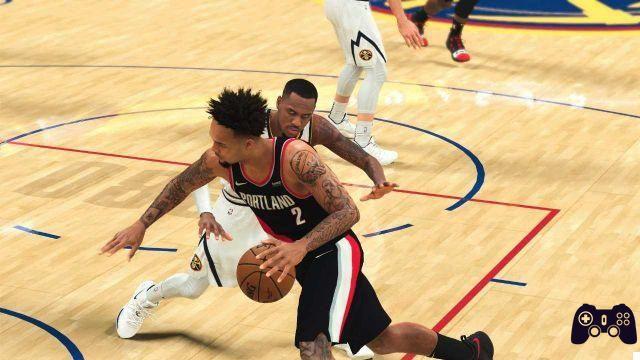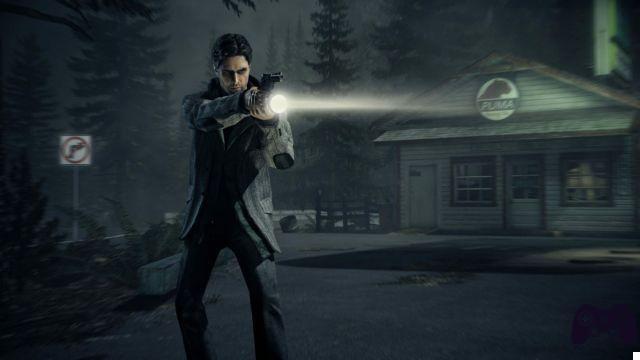Please note:
The solution is based on the US version of the game for Nintendo DS. There may be divergences from the Spanish version and / or for other platforms.
Initial hints
After the vision with which the game opens, you will be asked to make some choices that will outline the character you are going to impersonate. Not only will you have to decide on their sex, but also where they usually live. The playing area is in fact made up of two cities, Bluebell and Konohana. The former mainly hosts livestock breeders, while the latter specializes in crops. Between the two cities lies a mountain range, densely populated by wild animals. This unspoiled place is also ideal for the growth of different varieties of plants and the development of mountain lakes. Here you can also find unique varieties of mushrooms and insects. In addition to this, you will be able to specialize in the new bare hand fishing technique introduced in this new version of the series: rod fishing is still possible, and allows you to catch a large variety of fish, but in some situations it will be possible to use the your hands as a fishing tool.
At one time, a tunnel ran through the mountains to connect the two cities, but one day this was destroyed by an earthquake caused by the Harvest Goddess, annoyed by the constant bickering between the two cities.
You will soon meet the Hervest Goddess. The divinity is in fact a constant presence in the game, he will often appear to congratulate you on the results achieved, but will also require you to perform tasks in his stead, the first of which will be to rebuild a good neighborly relationship between the two cities. .
Despite the initial choice, during the course of the game you will be pushed to visit the city where you do not live as a tourist, to discover how it presents commercial opportunities that do not exist in the city where you reside. At each change of season you will also be given the opportunity to change your home. From time to time, therefore, it is good that you move your residence to the other city so that you can take full advantage of all the opportunities that the game offers. Meanwhile, note that, despite the characterization of the two cities illustrated at the beginning, it is also possible to cultivate the land in Bluebell and raise animals in Konohana.
The game inherits some aspects from previous versions. Some options in fact follow those available in Rune Factory, including the Message Board with the Requests, while others have undergone small changes: the icons in the shape of a flower, for example, replace those in the shape of a heart. From Gran Bazar instead come some characters that you will meet during the adventure, including the trio of brothers and Pierre the Gourmet: the latter is now president of the Cooking Festival, a very useful party occasion for rebuilding relations between the two cities. Nathan returns too: you can find him in Bluebell's church.
Finally, just like in the Grand Bazaar, you will be able to adopt puppies to help you control the livestock.
The residence
The first choice to make during the game is the city in which to settle. Whenever you are called to make a choice of this type in a video game, you are afraid that your decisions may end up precluding some future possibilities in the continuation of the adventure.
In this case, however, the choice of one city rather than the other will certainly have repercussions on what you will do later, but will result in an impediment to any type of activity. In fact, your decision will only determine the order in which some options will be introduced, as well as the distance between your home and some shops. In fact, certain types of commercial activities will only be available in one of the two cities and to reach them, if they are not in the city you live in, you will have to take a long walk from one side of the game area to the other through the mountain region. However, not all evil comes to harm: the mountains are rich in resources and especially in the initial phase of the game they represent the place from which most of the income will derive, so long walks in the mountains will certainly not represent a nuisance, but could often prove to be excursions full of opportunities.
As mentioned, some types of shops can only be found in one of the two cities. Here is a list of the unique businesses in each city.
Bluebell:
Bluebell Town Hall
Cam's Flower's
Diego's General Store
Eileen's carpentry Shop
Grady's Animal
Howard's Café
Jessica's Livestock
Coelacanth:
Knohana Town Hall
Konohana Clinic
Gombe's Seed
Kana's Animal
Mako's orchard
Sheng's Smithy
Yun's tea House
Beyond the location of some shops, there are other differences between the two cities, which however you will only see emerge in the more advanced stages of the game. In Bluebell you can build a bee farm, dairy, tailor shop and puppy training; in Konohana instead you can have rice fields, flour mills, breweries and fishing lakes. To get a better idea of these options, as you advance you can consult the books that you find at the beginning of the game in the Town Halls of the two cities.
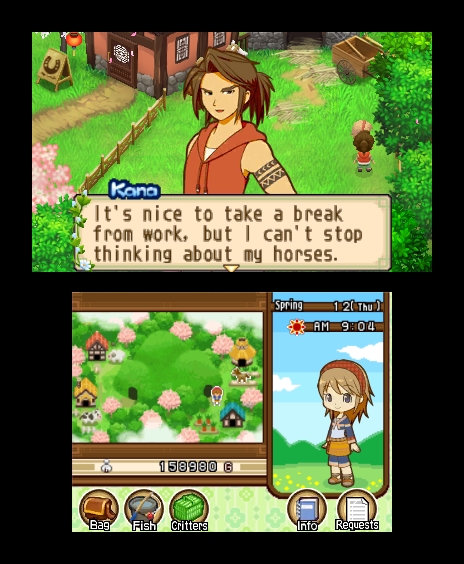
requests
The Requests system is the hub of social relations in this new version of Harvest Moon, and it works just like that of Rune Factory. Each city has a Message Board in the central square on which some requests appear. At the beginning of the game you will already find some simple requests to satisfy: these initial requests work as a tutorial and involve the collection of a particular object. If you have managed to find the object yourself without following the suggestions in the request, you can safely skip this step. However, other requests guide you in understanding some elementary tasks, such as catching insects, fishing with bare hands and managing social relations with the other inhabitants of the city. The initial requests are identical for both cities, although obviously they will be placed by different inhabitants. If you want to learn more about the functioning of the requests during the game, you can consult the books related to the subject present in the Town Hall. Alternatively, read on.
Basic notions
After reviewing the City Message Board and choosing the request you want to fulfill, select it. As you can see, each request has a time limit within which it must be carried out. In general, you will often find yourself having to deliver items within the time limit (note that the item can also come from your shopping cart), but this is not always the case. Sometimes the request for help does not concern an object, but a particular task; other times the request is made by an inhabitant on behalf of another citizen, so be sure to read carefully what is required of you! Some requests, especially early in the game, may seem beyond your reach. However, if you fail to fulfill a request, you will not be subjected to any penalty, so feel free to try every feat. If, on the other hand, you manage to satisfy the requests of one of your fellow citizens, you will be rewarded with a prize. However, this prize must be deposited inside your bag and if it is full, you will be forced to empty it of one of the objects inside it to accept the reward. Before accepting a request, therefore, make sure you have space inside your bag (or on your cart) for the prize.
Levels and ratings
The requests are divided into different levels and after satisfying a certain number of requests you will be promoted to the next level. There are five levels: D, C, B, A and S. As the level increases, the difficulty of the request to be fulfilled increases, but at the same time the rarity and value of the object that you can receive as a reward also increases. As the level increases, the number of requests that you can accept at the same time also increases: initially there will be only ten, but during the course of the game you will be able to accept many more. Just make sure you don't accept the maximum number of requests, as it is not possible to cancel them, and therefore you will find yourself unable to accept them again until you satisfy at least one, or until the maximum time expires.
The first requests that are submitted to you at the beginning of the game come from Rutger or Ina, depending on the city in which you have decided to settle, and allow you to get a cow and a hen, in the first case, or turnip seeds and potatoes in the second. Upon satisfactory request, you will also be subjected to a tutorial on breeding or cultivation, again depending on the choices made previously.
The role of requests
The request system plays a very important role in the game world of The Tale of Two City. In fact, requests represent a much cheaper alternative to buying and selling objects / animals. In fact, requests often concern the search for objects or insects which, if sold, would prove to be of little value. By handing them over to the citizen who has requested them, you will be rewarded with other items with a value significantly higher than those delivered, as well as useful: the rewards in fact often include ingredients, vegetables or animal feed.
The house
Regardless of your city choice, your home will initially look the same: a bare kitchen, a closet, a calendar and a cart, a bookcase, a vase of flowers, and a bed. The kitchen can initially be used to make only recipes that do not require the use of tools. Wait for the first Cooking Festival to arrive to get a pot to use in the kitchen. On the library, on the other hand, you will find the Asset menu, the place to read the information concerning you: initially you will only find your Farm Title, which will necessarily be "beginner" ??, in addition to the date of your birthday.
Also note that in the flowerpot you can only store flowers that you have grown and not wild flowers collected during the exploration.
Finally, the bed allows you to rest and save: to save your game progress you will necessarily have to use the bed. Rest also allows your character to bring the energy bar back to maximum. Be careful as many of the actions you can take affect your energy level. However, remember that you can also improve your energy level by eating: the increase in energy in this case depends on the type of food you eat.
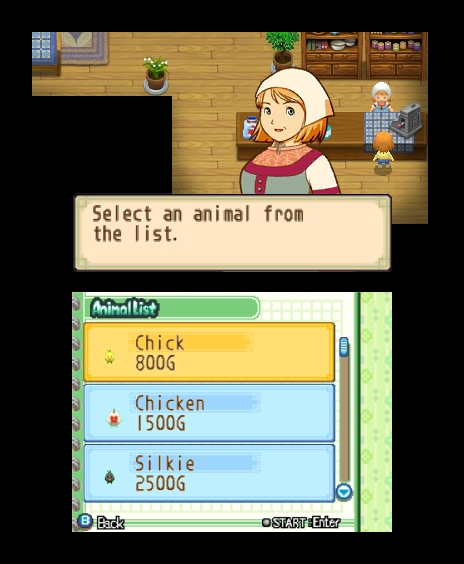
Care of the crop
Agriculture is a fundamental element of the game, and you can take care of it even if you have chosen to live in Bluebell, the most dedicated to livestock town.
The main tools necessary for sowing and harvesting will be given to you as a gift. If you have decided to live in Konohara, Ina will give you the first day of play after the first request. If, on the other hand, you live in Bluebell you will have to wait until the 10th of spring to receive them as a gift from Rutger. If you have the patience to complete the farming tutorial, you will then be rewarded with seeds to start sowing.
Remember that before you can sow a field, you will have to worry about cleaning it of weeds and rocks using the rake. By taking care of Ina's first request and following the simple initial tutorial, you will still have all the information you need to become a master farmer.
Keep in mind that the products of your fatigue lose freshness over time. As you will notice at the beginning, then the varieties of plants available to you are limited. You can get new seeds on particular occasions of the year, or even in particular years. However, there is also another way to collect new seeds ahead of time: to participate in Cooking Festivals. These demonstrations serve to increase the level of friendship between the mayors of the two cities, in order to mend relations between them as requested by the Harvest Goddess. However, these are still competitions and there are prizes up for grabs. Victory is usually rewarded with a rare item or seeds: however, it has been noted that the most important prize tends to be an item, while the consolation prize awarded for simple participation is very often a bag of seeds, the contents of which are random. However, simply participating in Cooking Festivals contributes to a lesser extent to the improvement of relations between the two cities.
The breeding
As with agriculture in Konohana, the principles of farming are illustrated to Bluebell in the tutorial phase through Rutger's words.
Pay close attention to a number of details. A portion of pet food consists of five rations: since you initially have only one cow and one hen, it means that portion will be enough for five days.
The placement of the cattle then is a decision to be carefully evaluated: the placement outside increases the level of friendship between the animals more rapidly, in good weather conditions. However, with bad weather there could be drawbacks. Since you will spend the initial phase of the adventure wandering around the play area without being able to pay too much attention to the livestock, and given the suddenness with which the weather conditions can change, it is advisable to place the animals in shelter, at least initially. However, if you prefer to leave your animals in the open air, equip yourself with a radio through which you can consult the weather forecast, which provides information on the expected weather during the day. However, if you have left the animals in the pasture and find that it is about to rain you will be forced to make a quick return home to take care of them. Going into more detail, it is necessary to differentiate the attention required to the care of poultry and that of other animals.
Make sure every day that there is chicken feed in the ground feeder and remember to lift each hen off the ground at least once a day: you will see a heart-shaped symbol appear on the animal, a symbol of gratitude. Also make sure to collect the eggs from the nest, as until the nest is emptied the hen will not be able to lay another.
Cows also need special care. First you will also need to check their manger and make sure it is not empty. Then take care of each cow by talking to it - using the A key - from time to time: also in this case a heart-shaped symbol will be the sign of the animal's gratitude. Then brush the cows, as they could get sick if they stay dirty for too long. Finally, remember to milk your cows every day.
Do not neglect your horse, on which you depend for the movements with the wagon. Brush him to increase your bond with him. If he falls ill, then take him to the resident who takes care of the animals and wagons for treatment.
The cart
Speaking of the horse, it is impossible not to say a few words about the cart. The wagon that is initially made available to you is an old bamboo wagon that can carry a limited number of objects. Furthermore, the horse will be frightened every time a wild animal crosses the road in the mountain area, spilling the contents of the wagon on the road.
In the course of the game you will be able to upgrade the tank thus increasing the slots available, but the best option is probably the purchase of a new tank. Note that after buying a new wagon, it will not automatically appear in place of the old one next to the house, but you will have to manually change it.
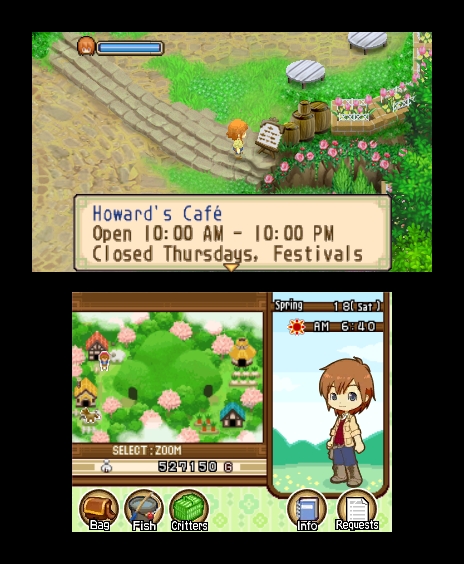
Pets
First, pets can be purchased from Grady in Bluebell, or from Kana in Knohana. Their usefulness lies mainly in the help they can lend to livestock-related activities. In fact, the dog can guard the cows, while the cat can take care of the chickens. To tame pets you will need a toy: a bell for the cats and a fake bone for the dog. Try to buy these items in the shops in the city where you live as their price is still high, but it will be even more so if the shopkeeper identifies you as a tourist. In any case, we are talking about 2500G or more for a cat bell. Also take into consideration the very likely possibility that your pet may lose his toy.
Kitchen
As mentioned earlier in relation to your home, initially in the kitchen you will be able to dedicate yourself only to recipes that do not require tools to be prepared. If you live in Konohana you only need to harvest nine ripe turnips to cook your first course. If you live in Bluebell instead you will have to wait a few more days, since with the ingredients at your disposal, eggs and milk, you will necessarily need a pot for cooking.
Notice how the kitchen menu allows you to cook recipes automatically, as long as you have the necessary ingredients. At the end of the first Cooking Festival you can therefore add a pot among the tools at your disposal and start cooking some simple dishes. By participating in the first Cooking Festival you will also get an onion, to be added to the ingredients list. By fulfilling some of the initial requests, you will also be able to dispose of butter. In this way, even if you live in Bluebell, you can start gaining some cooking experience.
However, you can always go to the shops to get the ingredients you need. In the spring you can find flour, rice and oil in Bluebell's General Store and Konohana's General Store. However, they may not always be available throughout the season, so it's best to stock up on them.
Cooking Festival
Cooking Festivals are much more frequent in this new version of Harvest Moon than in the past. Furthermore, the first assignment assigned to you by the Harvest Goddess is precisely connected to the Cooking Festivals, specifically to that of Mountaintop which sees the participation of both the mayor of Nokohana and that of Bluebell, and therefore represents an excellent opportunity to try to mend relations. between the two communities.
A couple of Cooking Festivals will be organized per season and you will be informed of their start through the calendar. The first Festival is held on the 7th of spring and your mayor - whatever city you have chosen to live in - will assign you ingredients and a recipe. The result of the competition is highly random, and largely depends on dishes prepared by the other team members, which you cannot influence. As mentioned, you will in any case receive a prize, represented by a vegetable or a bag of seeds - regardless of the result. The victory, however, leads to a slightly greater increase in the level of friendship between the two mayors, but the difference is so slight that it does not cause headaches. At the end of each Cooking Contest, the Harvest Goddess will report the progress in relations between the two cities: the increase is always in the order of half a heart, a little more if your team won, a little less if the your team has lost. From this you should easily deduce that simply participating in Cooking Contests contributes to the increase, albeit minor, of the friendship between Bluebelle and Nokohana.
More important to note, however, that after this first Contest you will receive the pot mentioned above, which is essential to start preparing slightly more elaborate dishes.
Money
As per the tradition of the Harvest Moon series, in the initial phase of the game, the only way to scrape together some credit is to rely on expeditions. To find out how expeditions are handled in this edition, just leave the farm screen for the first time, thus starting a cut-scene at the end of which you find yourself in front of the shipping basket together with the mayor of your city, Rutger o Ina.
The operation of the shipping system is simple: you can place the items you intend to sell in the basket by 5 am. At 6 o'clock the packages are sent and their value is credited: at that time the bell will alert you of the transactions and a screen will appear briefly to summarize the amounts.
Be careful not to accidentally insert objects into the basket: as long as the lid remains open, you can take back any objects deposited, but once closed, the objects inside are lost and will be sent to 6, without the possibility of recovering them. Don't be fooled by the dividers in your bag, you can safely ship the fish too.
To find out what the value of the items you want to ship is, just open the basket and thus bring up a small screen where the values of all the items contained in your bag will be listed. The value is fixed, except for objects identified by Quality Stars: in this case the value will increase as the stars increase. Since initially the expedition will be the only source of income, pay close attention to the management of your items: the initial space in the bag is limited, and the same goes for that on the wagon. However, the items inside the bag tend to deteriorate faster than those on the wagon, so take this into account when sorting.
The montana area
You won't have much of a chance to accumulate credits initially. Those who have chosen to live in Konohana will be able to raise a few more bucks, as agricultural activity starts before breeding, but whatever your initial choice about the city of residence, the mountain area represents an invaluable resource. There, in fact, using only your hands, you could collect fruits, herbs, bamboo, wild flowers, but also fish, insects and useful building materials. However, hunting will not be easy! Insects, for example, are fast, and are often alerted by the slightest noise: you must therefore be silent, but incredibly smart. For fishing, on the other hand, you can resort to the classic technique, equipping yourself with a fishing rod, hook, and a lot of patience, or chase the fish in the streams and catch them with your bare hands by pressing the A key with the right timing. In fact, some fish can only be caught with bare hands, others only with traditional fishing. In any case, for more information on the fish and all the other wonders of nature - and not - that populate the mountain area, be sure to read carefully the book "Wonders of the Mountains" which is located in the Town Hall of your city. .
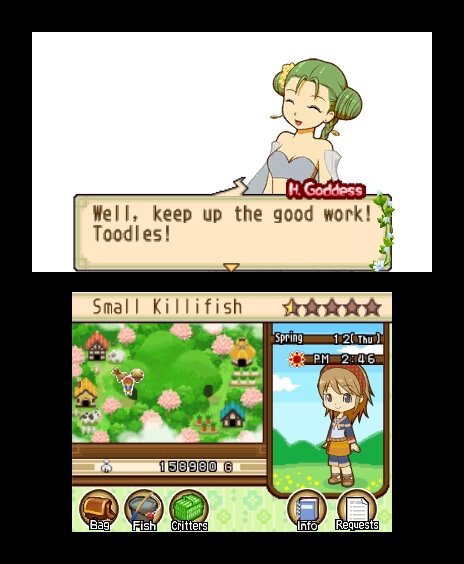
Calendar
Spring Season:
1 Spring:
New Year
4 Spring:
Giorgia's birthday
6 Spring:
Mako's birthday
7 Spring:
Cooking Festival.
It starts in the afternoon at Mountaintop. Remember the salad!
Bluebell e Konohana
9 Spring:
Cherry Blossom Festival
It starts in the afternoon at the Town Hall. Bring a plate to share.
Konohana
13 Spring:
Cooking Festival.
It starts in the afternoon at Mountaintop. Bring a soup.
Bluebell e Konohana
14 Spring:
Primavera Harmony Day.
On this holiday, the boys give the girls some chocolate.
Bluebell
15 Spring:
Children's Festival
It starts in the afternoon at the Town Hall. Bring a dessert.
Konohana
16 Spring:
Rutger's birthday.
19 Spring:
Cooking Festival.
It starts in the afternoon at Mountaintop. Bring a first course.
Bluebell e Konohana
20 Spring:
Asha's birthday.
24 Spring:
Cheryl's birthday.
25 Spring:
Primavera Crop Festival
It starts in the afternoon at the Town Hall. Bring your best turnip!
Konohana
26 Spring:
Spring Animal Festival.
It starts in the afternoon at the Town Hall. Bring your best hen!
Bluebell
27 Spring:
Nori's birthday
29 Spring:
Cooking Festival.
It starts in the afternoon at Mountaintop. Bring a dessert.
Bluebell e Konohana
Summer:
3 Estate:
Critter Contest
It starts in the afternoon at the Town Hall. It is a competition to see who collects the most Critters in the mountain area.
Konohana
5 Estate:
Ina's birthday.
6 Estate:
Barefoot fishing competition
It starts in the afternoon at the Town Hall. It is a competition to see who collects the most fish in the mountain area.
Bluebell
7 Estate:
Grady's birthday
9 Estate:
Cooking Festival.
It starts in the afternoon at Mountaintop. Bring a salad.
Bluebell e Konohana
10 Estate:
Flower Festival.
Give a flower to anyone you meet!
Bluebell
12 Estate:
Dirk's birthday
13 Estate:
Kana's birthday
14 Estate:
Cooking Festival.
It starts in the afternoon at Mountaintop. Bring a soup!
Bluebell e Konohana
15 Estate:
Angling Contest.
It starts in the afternoon at the Town Hall. It's a competition to see who catches the biggest fish!
Konohana
17 Estate:
Jessica's birthday.
18 Estate:
Stargazing Festival.
It starts in the afternoon at the Town Hall. All together gazing at the stars!
Bluebell
19 Estate:
Cooking Festival.
It starts in the afternoon at Mountaintop. Bring a first course.
Bluebell e Konohana
21 Estate:
Birthday of Diego, Raul and Enrique.
23 Estate:
Laney's birthday.
25 Estate:
Suimmer Crop Festival.
It starts in the afternoon at the Town Hall. Bring your best radish!
Konohana
26 Estate:
Summer Animal Festival.
It starts in the afternoon at the Town Hall. Who will win this race for the best dog?
Bluebell
28 Estate:
Cooking Festival.
It starts in the afternoon at Mountaintop. Bring a dessert!
Bluebell e Konohana
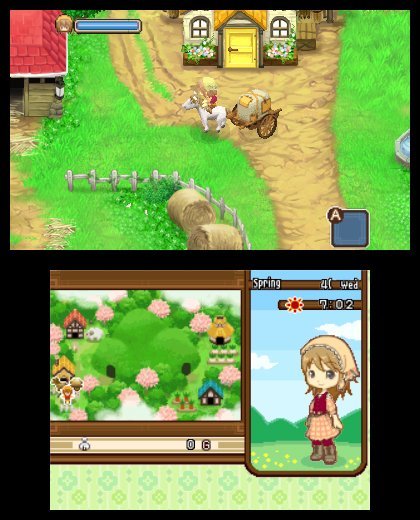
Autumn:
1 Autumn:
Cam's birthday.
4 Autumn:
Birthday of Nathan and Frey / Freya.
7 Autumn:
Cooking Festival.
It starts in the afternoon at Mountaintop. Bring a salad.
Bluebell e Konohana
8 Autumn:
Sheng's birthday.
10 Autumn:
Music Festival.
It starts in the afternoon at the Town Hall. An excellent opportunity to listen to good music.
Bluebell e Konohana
12 Autumn:
Mikhail's birthday.
14 Autumn:
Cooking Festival.
It starts in the afternoon at Mountaintop. Bring a soup.
Bluebell e Konohana
15 Autumn:
Moon Viewing Festival.
Go to the Town Hall at 8pm and join your fellow citizens to admire a magnificent moon.
Konohana
16 Autumn:
Rahi's birthday.
18 Autumn:
Flower Day.
Give a flower!
Konohana
21 Autumn:
Cooking Festival.
It starts in the afternoon at Mountaintop. Bring a first course!
Bluebell e Konohana
23 Autumn:
Rose birthday.
25 Autumn:
Fall Crop Festival.
Start in the afternoon at the Town Hall: the most beautiful carrot will win a prize!
Konohana
26 Autumn:
Autumn Animal Festival.
Start in the afternoon at the Town Hall: the most beautiful sheep will win a prize!
Bluebell
27 Autumn:
Howard's birthday.
28 Autumn:
Cooking Festival
It starts in the afternoon at Mountaintop. Bring a dessert!
Bluebell e Konohana
30 Autumn:
Ayame's birthday.
31 Autumn:
Pumpkin Festival.
Pumpkin festival! Give sweets to children who knock on your door.
Bluebell
Winter:
5 Winter:
Hiro's birthday.
7 Winter:
Cooking Festival.
It starts in the afternoon at Mountaintop. Bring a salad.
Bluebell e Konohana
9 Winter:
Eileen's birthday.
10 Winter:
Snow Festival.
Go to the Town Hall in the afternoon to admire the works of art made with snow!
Konohana
12 Winter:
Yun's birthday.
14 Winter:
Winter Harmony Day
On this special occasion, girls give chocolates to boys.
Bluebell
16 Winter:
Cooking Festival.
It starts in the afternoon at Mountaintop. Bring a soup.
Bluebell e Konohana
17 Winter:
Alisa's birthday. You can only meet Alisa in the autumn of the second year.
19 Winter:
Ying's birthday.
21 Winter:
Cooking Festival.
It starts in the afternoon at Mountaintop. Bring a first course!
Bluebell e Konohana
22 Winter:
Gombe's birthday.
24 Winter:
Starry Night Festival.
The party of the lovers!
Bluebell
27 Winter:
Reina's birthday.
28 Winter:
Cooking Festival.
It starts in the afternoon at Mountaintop. Bring a dessert!
Bluebell e Konohana
30 Winter:
Oracle birthday. You only meet him in the second year of play.
31 Winter:
New Year's Festival
The New Year's Eve party starts in Twon Hall at 8pm.
Bluebell e Konohana
Video - Gameplay of the game
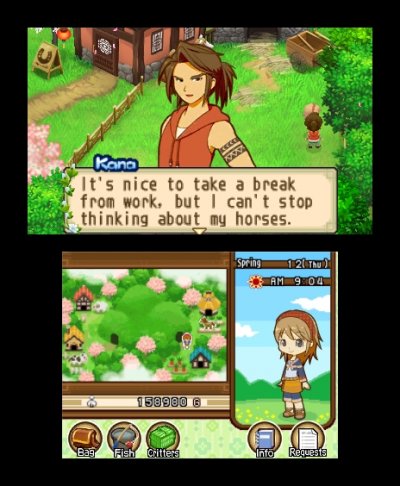 Harvest Moon: The Tale of Two Towns 3ds
Harvest Moon: The Tale of Two Towns 3ds
- ds
- 3ds
Exit date: 2012




